Golden gumleaves reveal hidden mineral deposits
CSIRO scientists have discovered that eucalyptus trees in Western Australia’s Kalgoorlie are drawing up gold particles from the earth via their root system and depositing it in their leaves and branches. Their findings have been published in the journal Nature Communications.
CSIRO geochemist Dr Mel Lintern explained that the discovery reveals the existence of gold deposits beneath the trees - in some cases up to 30 metres below the surface under sediments that are up to 60 million years old.

“The eucalypt acts as a hydraulic pump - its roots extend tens of metres into the ground and draw up water containing the gold,” Dr Lintern said. “As the gold is likely to be toxic to the plant, it’s moved to the leaves and branches where it can be released or shed to the ground.”
The gold was detected using CSIRO’s Maia detector for X-ray elemental imaging at the Australian Synchrotron. Dr David Paterson, a principal scientist at the Australian Synchrotron, noted that the nuggets are “about one-fifth the diameter of a human hair and generally invisible by other techniques and equipment”.

Dr Lintern said the synchrotron is “able to analyse elements such as gold in three dimensions within the leaf and this has enabled us to see that the gold is actually contained within the leaf and not on the surface as dust”. The researchers write that this is “the first evidence of particulate Au within natural specimens of living biological tissue”, noting that “although Au has been previously measured in plant samples, there has been doubt as to whether it was truly absorbed rather than merely adsorbed on the plant surface as aeolian contamination”.
The confirmation of absorption could provide an opportunity for a more cost-effective and environmentally friendly method of mineral exploration. Dr Lintern said, “By sampling and analysing vegetation for traces of minerals, we may get an idea of what’s happening below the surface without the need to drill.” Other metals which could potentially be found in the leaves include zinc and copper, she added.

Dr Lintern noted that while some trees do take up gold, others don’t, “so we need to do some more research to find out why this is happening, to make it into a robust exploration technique”. But the current results are promising and the potential for exploration could provide a boost to the national economy. Dr Lintern said, “Eucalyptus trees are so common that this technique could be widely applied across Australia.”
European Space Agency inaugurates deep space antenna in WA
The ESA has expanded its capability to communicate with scientific, exploration and space safety...
Black hole collision supports Hawking's landmark theory
Astrophysicists have witnessed a collision between two black holes that was so loud, they were...
Uncovering differences in wild and domesticated crops
Researchers have revealed insights into the genetic make-up of wild varieties of common crops...





